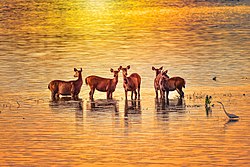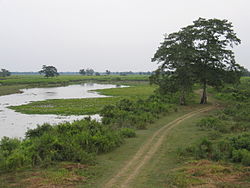Kaziranga National Park
Kaziranga National Park is a national park in India. The park is home to two-thirds of the world's great one-horned rhinoceroses.[1][2] It is a World Heritage Site.[3] It was named a Tiger Reserve by the government of India[4] and an Important Bird Area by BirdLife International.[5]
| Kaziranga National Park | |
|---|---|
| Kaziranga Rashtriya Udyaan | |
IUCN Category II (National Park) | |
 Adult Indian rhinoceros with a calf at Kaziranga National Park | |
| Location | Golaghat and Nagaon, Assam |
| Nearest city | Golaghat, Nagaon |
| Area | 430 km2 (170 sq mi) |
| World Heritage Site | World Heritage Place by UNESCO since 1985 |
Kaziranga is home to large breeding populations of tigers, elephants, wild water buffalo, and swamp deer.[3][6] One type of swamp deer now only exists in the park.[7]
History
The Kaziranga Proposed Reserve Forest was created in 1905. Mary Curzon, the wife of the Viceroy of India, wanted the area protected mostly to save the rhinoceros. In 1908, Kaziranga was designated a "Reserve Forest". In 1916 it was renamed "Kaziranga Game Sanctuary" then changed to “Wild Life Sanctuary” in 1950.
Geography
The park is located in both the Nagaon district and Golaghat district, in the state of Assam in India. It is about 40 kilometres (25 mi) long and 13 kilometres (8 mi) wide.
The park is crossed by four main rivers — Brahmaputra, Diphlu, Mora Diphlu and Mora Dhansiri. There are also many small water bodies.
The park is within the Brahmaputra floodplain. This means when the water in the river rises, the park is partially covered in water. Flooding happens every year which results in over half the park being underwater. In 2017, 85% of the park was underwater.[8] At least 107 animals died because of the flooding in 2017.[8] There are elevated areas of the park which provide retreats and shelter for animals during floods. These are called chapories. Many artificial chapories have been built with the help of the Indian Army to ensure the safety of the animals.[9]
Climate
The park has three seasons: winter, summer, and monsoon. The winter season is between November and February. It is mild and dry. The small water bodies dry up and short grass covers the bed.[10] The summer season between March and May is hot. The animals can be found near water during these months.[10] The rainy monsoon season lasts from June to September.
Fauna
Kaziranga National Park is home to 35 major mammals. This includes 15 mammals under the highest protection in India.[11][12] The One-Horned rhinoceros, Royal Bengal Tiger, Asian elephant, wild water buffalo and swamp deer are collectively known as the 'Big Five' of Kaziranga. In addition there are gaur, sloth bears, clouded leopards, wild boar, and several deer species. Small mammals include the rare hispid hare, mongoose, civet, pangolin, and badgers. The park also is home to several primates. These include macaques, lutungs, the Bengal slow loris, and the only ape in India - the hoolock gibbon.[13] Kaziranga's rivers are home to the endangered Ganges dolphin.[3]
More than 490 bird species live in Kaziranga which includes 24 globally threatened species.[5] The park is known for its nesting colonies of Spot-billed Pelicans and Adjutants.[5] Waterfowl which breed in or pass through Kaziranga include several rare species of geese (lesser white-fronted goose), and ducks (ferruginous pochard, Baer's pochard). Other rare riverine birds include kingfishers, herons, shanks, and terns. Raptors include the rare eastern imperial eagle, other eagles, and the lesser kestrel.
Two of the largest snakes in the world, the reticulated python and the rock python, are common inside the park. It is also home to the king cobra, Indian cobra, Russell's viper, and common krait. Fifteen species of turtle live in Kaziranga.[11] 42 species of fishes are found in the Kaziranga area, including the unusual ocellated pufferfish.[14]
Flora
There are four main types of plant life in Kaziranga National Park.[15] These are alluvial inundated grasslands, alluvial savanna woodlands, tropical moist mixed deciduous forests, and tropical semi-evergreen forests. Percent coverage by vegetation is: tall grasses 41%, short grasses 11%, open jungle 29%, swamps 4%, rivers and water bodies 8%, and sand 6%.[16]
Kaziranga National Park Media
Mary Curzon, Baroness Curzon of Kedleston and her husband are credited with starting the movement to protect this area.
An Indian roller at Kaziranga
References
- ↑ Rowlatt, Justin (10 February 2017). "Kaziranga: The park that shoots people to protect rhinos". BBC. Retrieved 15 November 2017.
- ↑ Bhaumik, Subir (17 April 2007). "Assam rhino poaching 'spirals'". BBC News. http://news.bbc.co.uk/2/hi/south_asia/6564337.stm. Retrieved 14 November 2017.
- ↑ 3.0 3.1 3.2 "Kaziranga National Park". UNESCO. Retrieved 15 November 2017.
- ↑ "NO.FRW- 6/2007/23" (PDF). Government of Assam. 3 August 2007. Retrieved 20 November 2017.
- ↑ 5.0 5.1 5.2 "Kaziranga National Park". BirdLife. Retrieved 20 November 2017.
- ↑ Singh, Satyendra (6 February 2017). "Kaziranga National Park". Retrieved 20 November 2017.
- ↑ "Rucervus duvaucelii". Retrieved 20 November 2017.
- ↑ 8.0 8.1 Mitral, Naresh (Aug 14, 2017). "85% of Kaziranga under water in its worst deluge since 1988". The Times of India. Retrieved 29 November 2017.
- ↑ "State of Conservation of the World Heritage Properties in the Asia-Pacific Region" (PDF). UNESCO. p. 3. Retrieved 29 November 2017.
- ↑ 10.0 10.1 Mathur, V.B.; Sinha, P.R.; Mishra, Manoj. "UNESCO EoH Project_South Asia Technical Report–Kaziranga National Park" (PDF). UNESCO. Archived from the original (PDF) on 30 May 2008. Retrieved 2008-08-23.
- ↑ 11.0 11.1 "Wildlife in Kaziranga National Park". Kaziranga National Park Authorities. Retrieved 28 November 2017.
- ↑ "UN Kaziranga Factsheet". UNESCO. Archived from the original on 2008-05-10. Retrieved 2007-02-23.
- ↑ "Hoolock Gibbon". WWF India. Retrieved 29 November 2017.
- ↑ "Kaziranga National Park-Fish List". Kaziranga National Park Authorities. Archived from the original on 2007-09-28. Retrieved 2007-02-24.
- ↑ Talukdar, B. (1995). Status of Swamp Deer in Kaziranga National Park. Department of Zoology, Guwahati University, Assam.
- ↑ Kushwaha, S.& Unni, M. (1986). Applications of remote sensing techniques in forest-cover-monitoring and habitat evaluation—a case study at Kaziranga National Park, Assam, in, Kamat, D.& Panwar, H.(eds), Wildlife Habitat Evaluation Using Remote Sensing Techniques. Indian Institute of Remote Sensing / Wildlife Institute of India, Dehra Dun. pp. 238–247
Other websites
| Wikivoyage has a travel guide about: Kaziranga National Park |
- Official website of Kaziranga Archived 2022-06-19 at the Wayback Machine









